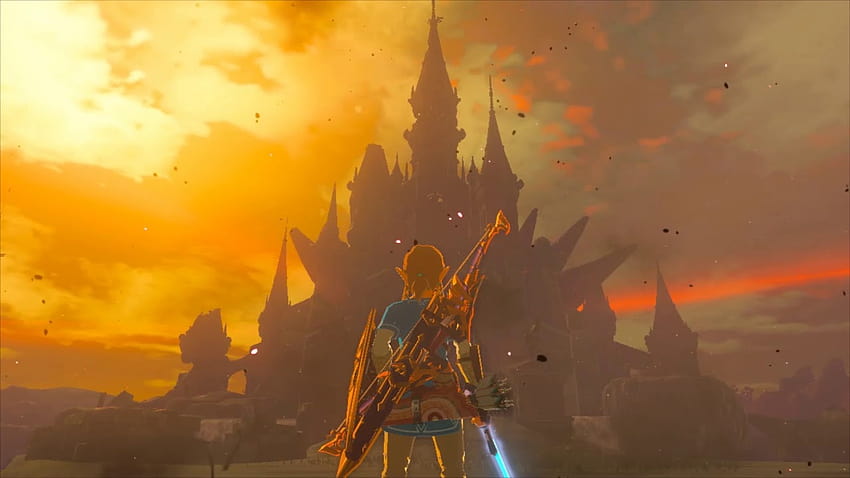Hyrule Castle Is the Geographical and Emotional Heart of Breath of the Wild
Posted on January 29 2023 by Sean Gadus

Breath of the Wild is filled with stunning landmarks and locations that can elicit an emotional response from the player. Whether it is the sun-drenched Gerudo Town, the frigid majesty of the Hebra Mountains, or the tranquil Zora’s Domain, the game is full of inspiring and imposing landmarks. Despite the numerous honorable candidates for the most important and iconic landmark in the game, one location stands above the rest: Hyrule Castle. The decaying ruin is the geographical and narrative heart of Breath of the Wild.
Located at the center of Breath of the Wild‘s massive map, Hyrule Castle is the most brilliantly designed location in the game. The massive castle serves as a sort of compass; the player can use the location of the decaying castle to identify what direction they need to travel in. In addition to its value as a physical landmark, the location also is a powerful symbol in Breath of the Wild‘s story. A haunting reminder of the triumph of evil, the castle is a representation of Hyrule’s downfall and Link’s own failure one hundred years ago. Finally, the castle serves as Breath of the Wild‘s final challenge, an innovative “choose your own adventure” style dungeon that gives the player the freedom to explore as lightly or deeply as they want to. No one location has meant more to a Zelda game than Hyrule Castle means to Breath of the Wild. It is grandeur and decay, the past and future, the alpha and omega, all wrapped in one.
A Brilliant Directional Tool That Helps The Player Navigate A Sprawling World

Breath of the Wild is an absolutely massive game, and exploration is a key theme within it. In order for Breath of the Wild to succeed as an open world game, the player has to feel comfortable navigating the enormous amount of space that they are thrown into. Once the player leaves the Great Plateau, they can travel in any direction. This means that Breath of the Wild‘s developers and designers had to be precise in how they designed the game world. The developers of Breath of the Wild use a series of natural and man-made landmarks to help the player navigate through the world. The most important geographical landmark and directional tool is Hyrule Castle. The massive structure is clearly visible from the Great Plateau, and Link can often spot its spires while standing on different elevated areas across the game. The player can often use the location of Hyrule Castle to help identify their location, as well as the direction they need to travel in to get to a specific location, all without having to pause the game to take a look at their map.
The location of Hyrule Castle and its use as an anchor landmark is similar to strategies used by theme parks and attractions to subtly encourage visitors to venture deeper into their parks. Many amusement parks are built with a landmark near their centers, which is designed to draw attendees into their parks and towards their centers. Disney refers to the idea of using a landmark as a visual compass or geographical aide a “weenie,” an expression that dates back to Walt Disney and his dog. The idea of weenies has had an influence on how many theme parks have been designed over the past decades, and other game series like Uncharted have used landmarks to help guide player movement and exploration. When looking at Hyrule Castle in Breath of the Wild and Cinderella’s Castle in Disney’s Magic Kingdom, it is clear that the two serve similar functions in their respective worlds.
By looking at the some basic components of weenies, we can appreciate the design and location of Hyrule Castle even more. A weenie usually has a clear form or distinct style that contrast with its surroundings. Usually, the location is in a prominent or key location. In Breath of the Wild, the towers and spires of Hyrule Castle are extremely distinct from other landmarks across the world. The hazy red and black miasma surrounding the Castle, along with the decaying stone work, look starkly different from the lush fields and rolling hills that surround Hyrule Castle Town. In short, Hyrule Castle is the most recognizable landmark in the game, visually distinct from the other landmarks and locations on the map. The designers of Breath of the Wild take advantage of human navigational tendencies to follow points of interest, and they made Hyrule Castle the player’s geographical anchor.
A Tragic Symbol Of Loss and Grief

Not only is Hyrule Castle a key navigational tool; the hulking, crumbling castle plays a key role in the story in Breath of the Wild. Generally, the castle is usually considered a symbol of authority, power, and strength; in short, the castle often serves as a representation of a strong kingdom or strong ruler. In several cutscenes set in the one hundred years before the start of Breath of the Wild, Hyrule Castle Town and Hyrule Castle act as a representation of a thriving kingdom. While the player has only a limited understanding of the downfall of the Kingdom of Hyrule at Breath of the Wild‘s opening, the ruins of Hyrule Castle immediately telegraphs the downfall of a once-great kingdom. While the people survive and struggle on, the greatest monument to Hyrule is occupied by the enemy.
The remnants of Hyrule Castle are a haunting, inescapable reminder of Link’s failure and defeat. Through the memories, the player learns that Link, Zelda, and the Champions tried to confront Calamity Ganon, only to be decisively routed by the enemy. The Guardians and other Sheikah technology once touted as a weapon against Ganon became his greatest asset. It is only Zelda’s final sacrifice, her eternal stalemate with Ganon inside Hyrule Castle, that keeps evil from consuming the remnants of the kingdom. Taking the road through the abandoned Hyrule Castle Town is a chilling experience, leaving the player with tragic unanswerable questions like, “How many people died because Link and Zelda could not stop Calamity Ganon?”
Hyrule Castle is not just a representation of Link’s past, but also our hero’s future. The player can see the castle in the background while they explore the Great Plateau, and it becomes obvious early in the game that Hyrule Castle is the final destination in Link’s journey. In order to complete his journey, Link must go to the place that represents his own failures. In order for Link and Zelda to move forward, they must exorcise the evil haunting the castle and the kingdom as a whole. Storming the castle is an emotional, cathartic capstone to Link’s resurrection.
A Flexible “Choose Your Own Adventure” Dungeon

Hyrule Castle is a fascinating dungeon, and in creating it, the developers created one of the best-designed castles in the history of video games. While many of the Shrines are clever small-sized puzzle rooms, Hyrule Castle is a much more expansive and sprawling space. The castle is rooted in real architectural concepts, and it is rare to have a Zelda dungeon that feels like a real place rather than a series of locked doors and puzzle rooms. The long, winding passages branch off into different rooms like the library, guard’s chamber, and the kitchen. In addition to the well-designed main rooms, the castle is full of secret passages that many people expect from a grand and complex castle.
One of the things that make Hyrule Castle such a special dungeon is that it is an innovative “choose your own adventure” dungeon, one that is driven almost entirely by the player’s own curiosity and creativity. The player can explore as much or as little of the castle as they want to. The decaying roofs and shattered wall mean that the player can drop into the interior from a dozen different locations. If the player wants to start at the bottom and climb all the way to the top, they may never need to enter the castle’s interior. In contrast, a player can make their way through the inner corridors and rooms, using secret passages and staircases to progress through the ruins. If the player has the Zora Armor, the player can even skip much of the dungeon by swimming up a series of waterfalls on one end of the castle. Few Zelda dungeons provide the player with this level of flexibility, with the player deciding on their own objectives and paths to the top.
The dungeon is also filled with interesting secrets that are littered across the massive space. The castle is home to some of the best weapons in the game, including a variety of Royal and Royal Guard swords, shields, and halberds. There is a bevy of hidden treasures and chests to discover for players who wish to farm for valuable resources or get rich quick. The player can spend hours exploring Hyrule Castle and still not find every secret the fortress has to offer. One of the best areas is a lock-up, where the player can obtain the Hylian Shield by defeating a Stalnox. The gatehouses contain thrilling optional fights against Lynels, which serves as some of the best combat encounters in the game. Another interesting area is Zelda’s Study, which contains Zelda’s journal and a Silent Princess flower. It’s beautiful to see the flower blooming amidst the decay and desolation.
Conclusion – An Epic Conclusion That Will Stand

Breath of the Wild‘s Hyrule Castle is the most iconic and most meaningful iteration of the castle across the entire Zelda series. The imagery of a sprawling, decaying castle will linger in the hearts, minds, and imaginations of fans for years to come. The musical theme for the castle — which contains a dramatic snare drum opening, bombastic horns, frantic piano runs, and a sinister organ — is one of the best themes in the series. Long after Breath of the Wild is succeeded by Tears of the Kingdom and other new Zelda games, fans will look back at Hyrule Castle as a huge highlight and lasting achievement for one of the best games of its generation. Hyrule Castle will be remembered for its key role as a navigational tool, a powerful lynchpin in the game’s story, and its innovative “choose your own adventure” design philosophy. Only time will tell if Hyrule Castle becomes the template by which the designers creates dungeons, or if it will stand alone as a unique achievement in open-world design.

Sean Gadus is a Senior Editor at Zelda Dungeon. His first Zelda game was Ocarina of Time, and he loves all of the 3D Zelda games from 1998-2011. The final battle of Tears of the Kingdom is one of his favorite final battles in the entire series. He wants to help build a kinder, more compassionate world. You can check out his other written work at The-Artifice.com.



